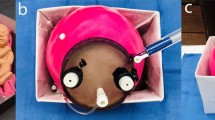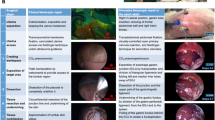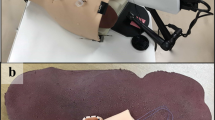Abstract
Purpose
The recent history of myelomeningocele has shown that treatment during the fetal life may reduce the risk of developing hydrocephalus in individuals by approximately 50%. Thus, a significant advancement involves fetal surgery performed through an endoscopic technique in which portals are placed to introduce the forceps and laparoscopic instruments. However, the development of this technique requires training; therefore, this study aimed to develop a training model for fetal myelomeningocele repair technique with multi-portal endoscopy.
Methods
Two stages of endoscopic technique development were performed. The first stage consisted of exercises in order to familiarize the surgeon with 2D-vision endoscopic surgery, associated with the application of exercises focused on surgical skills, such as the development of laparoscopic knots in a synthetic model. The second stage involved the creation and application of the stages of myelomeningocele closure with a non-living animal model consisting of a chicken breast to simulate the myelomeningocele and a basketball to simulate the gravid uterus, in which perforations were made to introduce vascular introducers (portals) that, as in vivo, are used as portals (trocars) for the introduction of laparoscopic instruments. Overall, two different scenarios with three portals and two portals were tested.
Results
In three-portal simulator, the triangular apex trocar was used for the introduction of 4-mm 0° or 30° optics or even Minop type neurodoscope (Aesculap®, Germany) that was operated by the assistant surgeon; the other two portals are used for the introduction of laparoscopic instruments. Thus, the surgeon is able to perform maneuvers bimanually since dissection to laparoscopic sutures. In two-portal simulator, the surgeon and assistant stay side by side and one of the portals is used for the optic and the other for the laparoscopic instruments. There is no possibility of bimanual dissection in this method.
Conclusion
Realistic simulation models for endoscopic fetal surgery for myelomeningocele correction are easily performed and help develop the necessary skills for fetal surgery teams.





Similar content being viewed by others
Data availability
Not applicable.
References
Mai CT, Evans J, Alverson CJ et al (2022) Changes in spina bifida lesion level after folic acid fortification in the US. J Pediatr 249:59–66.e1. https://doi.org/10.1016/J.JPEDS.2022.06.023
Adzick NS, Thom EA, Spong CY et al (2011) A randomized trial of prenatal versus postnatal repair of myelomeningocele. N Engl J Med 364:993–1004. https://doi.org/10.1056/nejmoa1014379
Cavalheiro S, da Costa M, Moron A, Leonard J (2017) Comparison of prenatal and postnatal management of patients with myelomeningocele. Neurosurg Clin N Am 28:439–448. https://doi.org/10.1016/J.NEC.2017.02.005
Tulipan N, Wellons JC, Thom EA et al (2015) Prenatal surgery for myelomeningocele and the need for cerebrospinal fluid shunt placement. J Neurosurg Pediatr 16:613–620. https://doi.org/10.3171/2015.7.PEDS15336
Belfort MA, Whitehead WE, Shamshirsaz AA et al (2017) Fetoscopic open neural tube defect repair: development and refinement of a two-port, carbon dioxide insufflation technique. Obstet Gynecol 129:734–743. https://doi.org/10.1097/AOG.0000000000001941
da Costa MDS, Cavalheiro S, Camargo NC et al (2020) Fetal myelomeningocele repair: how many techniques are necessary? World Neurosurg 141:511–513. https://doi.org/10.1016/J.WNEU.2020.07.003
Belfort MA, Whitehead WE, Bednov A, Shamshirsaz AA (2018) Low-fidelity simulator for the standardized training of fetoscopic meningomyelocele repair. Obstet Gynecol 131:125–129. https://doi.org/10.1097/AOG.0000000000002406
Miller JL, Groves ML, Ahn ES et al (2021) Implementation process and evolution of a laparotomy-assisted 2-port fetoscopic spina bifida closure program. Fetal Diagn Ther 48:603–610. https://doi.org/10.1159/000518507
Patel SK, Kashyrina O, Duru S et al (2021) Comparison of two- and three-dimensional endoscopic visualization for fetal myelomeningocele repair: a pilot study using a fetoscopic surgical simulator. Childs Nerv Syst 37:1613–1621. https://doi.org/10.1007/S00381-020-04999-4
Joyeux L, Javaux A, Eastwood MP et al (2021) Validation of a high-fidelity training model for fetoscopic spina bifida surgery. Sci Rep 11:1–10. https://doi.org/10.1038/s41598-021-85607-6
Author information
Authors and Affiliations
Contributions
Marcos Devanir Silva da Costa: conceptualization, data acquisition, editing, and reviewing. Jardel Mendonça Nicácio: reviewing and editing. Patricia Alessandra Dastoli: reviewing and editing. Italo Capraro Suriano: supervision, reviewing, and editing. Stéphanno Gomes Pereira Sarmento: reviewing and editing. Mauricio Mendes Barbosa: sipervision, reviewing, and editing. Antonio Fernandes Moron: supervision, reviewing, and editing. Sergio Cavalheiro: supervision, reviewing, and editing.
Corresponding author
Ethics declarations
Ethics approval and consent to participate
The study was approved by the Research Ethics Committee of the Universidade Federal de São Paulo, São Paulo, Brazil.
Consent for publication
Not applicable.
Conflict of interest
No competing interests to declare.
Additional information
Publisher's Note
Springer Nature remains neutral with regard to jurisdictional claims in published maps and institutional affiliations.
Rights and permissions
Springer Nature or its licensor (e.g. a society or other partner) holds exclusive rights to this article under a publishing agreement with the author(s) or other rightsholder(s); author self-archiving of the accepted manuscript version of this article is solely governed by the terms of such publishing agreement and applicable law.
About this article
Cite this article
da Costa, M.D.S., Nicacio, J.M., Dastoli, P.A. et al. Training model for the fetal myelomeningocele correction with multiportal endoscopic technique. Childs Nerv Syst 39, 3131–3136 (2023). https://doi.org/10.1007/s00381-023-05893-5
Received:
Accepted:
Published:
Issue Date:
DOI: https://doi.org/10.1007/s00381-023-05893-5




